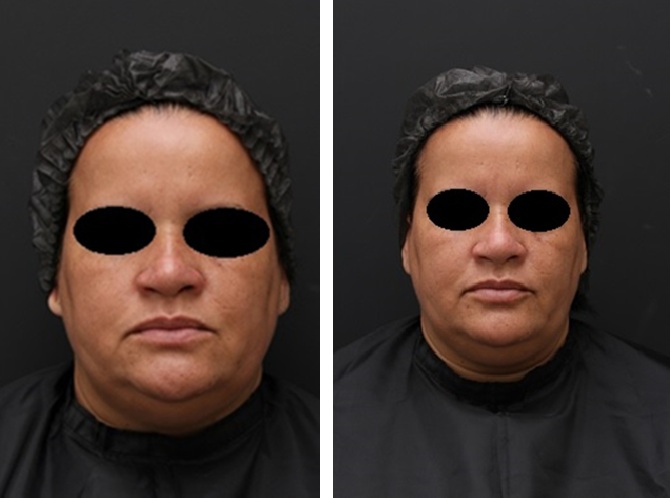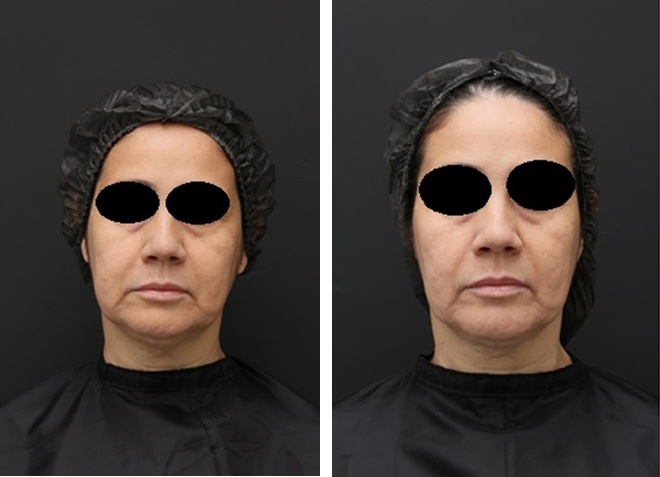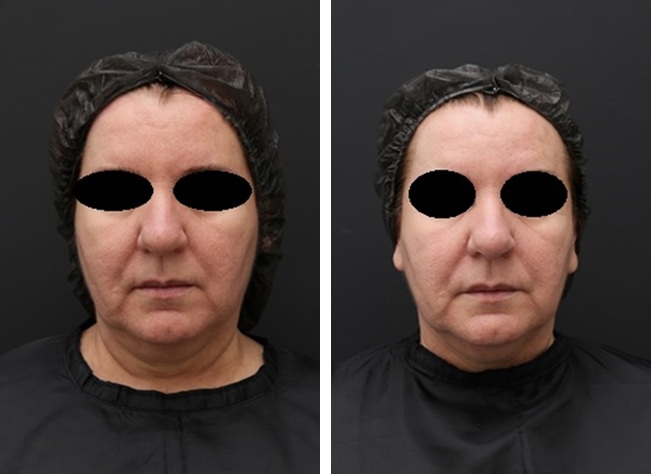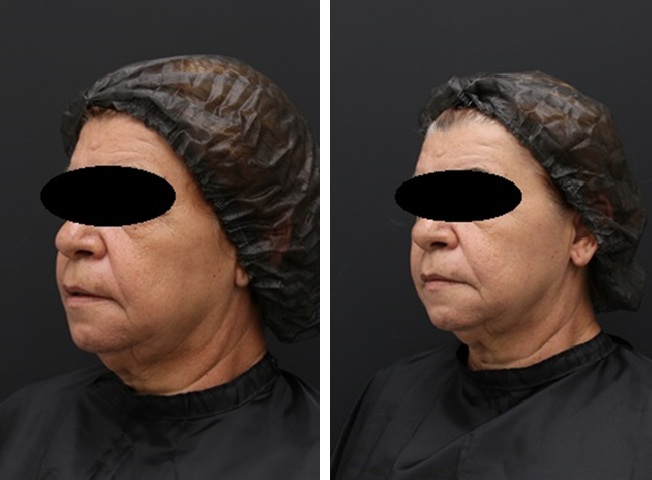
Drug Injections to Reduce Facial Fat
*Corresponding Author(s):
Lívia Arroyo TrídicoFaculdade De Medicina De Sao Jose Do Rio Preto, Dermatologia, São José Do Rio Preto, São Paulo, Brazil
Tel:+55 17997022525,
Email:latridico@gmail.com
Abstract
Facial aging involves not only the loss of volume, but also the ptosis of the fat compartments, leading to the emergence of deep folds and generating heterogeneous creases and depressions. Thus, this study aims to evaluate the drug injections of active principles in the subcutaneous tissue to reduce the puffiness in the jowl and nasolabial areas, and also the accumulation of fat in the submental area (“double chin”). Therefore, we describe the use of lipolytic and antioxidant substances to reduce facial fat in four patients who were very satisfied with the result of the treatment. Consequently, we conclude that the drug injections of active principles are a practical method with fast and promising results in the treatment of facial fat.
Keywords
Adipose tissue; Cosmetic dermatology; Injections
Introduction
Dermatological procedures to promote facial rejuvenation are increasingly popular. Filling, for example, is one of the main therapeutic options to recuperate the facial volume. However, before indicating dermatological procedures, it is essential that dermatologists understand the mechanism of transformation of a young skin into an aged skin. It is currently known that one of the main causes of facial aging is the changes in the facial fat compartments [1,2].
The facial aging process involves not only the loss of volume, but also the ptosis of the fat compartments. This causes the movement of facial fat, leading to the emergence of deep folds in the aged face, which generates heterogeneous creases and depressions [3]. Therefore, it is essential to understand such dynamics, since in some areas, such as the jowl and the nasolabial compartment, there is more inferior fat movement than volumetric loss [1,4]. In these cases, it is important to treat the fat compartments that have decayed with the aging process and to carefully fill in the areas that lost volume in order to avoid the unwanted effect of excess facial volume.
In view of the need to treat the fat compartments of the face, this study aimed to evaluate the drug injections of actives principles into the subcutaneous tissue to reduce the puffiness in the jowl, nasolabial areas and also the accumulation of fat in the submental area (“double chin”). Thus, we shall associate lipolytic substances (caffeine and l-carnitine) with antioxidant, draining and detoxifying substances (gotu kola, artichoke and green tea) to reduce facial fat.
The drug injection with active principles is a minimally invasive technique used in dermatology to distribute medications, vitamins, enzymes or other bioactive substances in the dermis or subcutaneous tissue in small amounts through multiple punctures [5-7]. Applying these substances directly to the affected area avoids systemic effects associated with oral and intravenous medications. It is also used in dermatology for the treatment of cellulite, alopecia, stretch marks, keloids, body contouring, among others [5,8]. The fat reducing actives have been used mainly for the treatment of body fat [9-12]. On the face, the main substances described for fat reduction are phosphatidylcholine and sodium deoxycholate [13-15]. Thus, the actives described in this paper shall be evaluated in an unprecedented way, in combination, for facial fat injection.
Materials and Methods
We have selected four female patients with fat puffiness in the jowl, lateral to the nasolabial fold and submental (“double chin”) areas to undergo a treatment with injection with active principles. The patients were aged between 45 and 60 years and were not undergoing any other dermatological treatment (whether topical, with injectables or technologies). The treatment protocol determined was to carry out four sessions of injections with active principles with an interval of fifteen days between each one. Before the first session and fifteen days after the last one common digital photographs and photographs in the QuantifiCare® imaging system were taken.
The active principles used in combination for the injection were l-carnitine, caffeine, Chinese Marigold extract, Cynarascolymus extract (artichoke), pineapple sativus extract and Camellia sinensis extract (green tea). Such association of active products characterizes the Toskani Slimming Cocktail®. In each session, we have applied 3 to 4 ml of the Toskani Slimming Cocktail® solution to each patient, distributed in the areas of facial fat accumulation.
The area to be treated was delimited by visually analysis of fat accumulation. The injection points were marked within the delimited area with a distance of 1 cm among them and at each point 0.05ml of the Toskani Slimming Cocktail® solution was applied. The injections of actives were made with a 0.30 X 13mm (30G) needle applied at a depth of 4 to 6 mm at an angle of 45º, aiming at delivering the substances in the subcutaneous layer. Before each injection of the solution, we carried out the aspiration with the needle to avoid intravascular application. The marginal branch of the mandible of the facial nerve was delimited in order to avoid injection in this area, thus preventing possible damage to the nerve [16].
Results
The four patients completed the treatment sessions with a 15-day interval between the applications. All patients reported being satisfied with the treatment, as, in addition to observing a reduction in fat compartments, they also reported an improvement in the quality and tone of the skin in the treated area. No material side effects were observed during the one month follow-up after the last session. Some patients only presented a hematoma in some points of the needle injection with spontaneous resolution in about one week after the procedure.
In a comparative analysis of the photographs using the QuantifiCare® system, we can verify a considerable reduction in fat compartments comparing the images before the first session and 15 days after the last session. In addition, we have also found an improvement in the freshness, quality and uniformity of the treated skin (Figures 1-8).
 Figure 1: Patient 1 before. Figure 2: Patient 1 after.
Figure 1: Patient 1 before. Figure 2: Patient 1 after.
 Figure 3: Patient 2 before. Figure 4: Patient 2 after.
Figure 3: Patient 2 before. Figure 4: Patient 2 after.
 Figure 5: Patient 3 before. Figure 6: Patient 3 after.
Figure 5: Patient 3 before. Figure 6: Patient 3 after. 
Figure 7: Patient 3 before. Figure 8: Patient 3 after.
Discussion
Among the non-surgical therapeutic options for reducing body and facial fat, we can mention high-intensity focused ultrasound, cryolipolysis, radiofrequency and the use of actives that can be topical (cream, gel and lotions) or injectable products [17-19]. The dissolution of subcutaneous fat through injections is on the rise in European and South American countries in the recent decades. Several studies report the efficacy of phosphatidylcholine, deoxycholate, l-carnitine, vitamin E, collagenase, hyaluronidase, isoproterenol, among others, with interesting results in the Caucasian population [20]. However, most studies assess body fat. When it comes to facial fat, the most used substances are deoxycholate (with recent FDA approval for use in the jowl) and the off-label use of phosphatidylcholine [20-22]. Fat reduction through injectable active products can occur through two mechanisms: lipolytic or ablative stimuli. The lipolytic stimulus is characterized by the reduction of fat cells through inhibition of the adenosine or phosphodiesterase receptor, activation of the beta adrenergic receptor or inhibition of the alpha 2 receptor. Thus, the adipocytes are not destroyed and the main substances that act in this same way are caffeine, aminophylline, isoproterenol, l-carnitine and yohimbine. The ablative mechanism, on the other hand, involves the destruction of adipocytes through a detergent substance, such as phosphatidylcholine and deoxycholate [23].
The Toskani Slimming Cocktail® solution used in this work has two lipolytic agents, namely the caffeine and l-carnitine, which mobilize the accumulated fat so that it can be metabolized. Caffeine increases lipolysis, elevating cyclic Adenosine Monophosphate (cAMP) through the inhibition of phosphodiesterase, in addition to increasing the release of catecholamine (epinephrine) by the sympathetic nervous system [5,24]. L-carnitine is an amino acid that constitutes an essential cofactor in the metabolism of fatty acids, acting in the reduction of triglycerides and cholesterol, increasing lipid oxidation and the delivery of long-chain free fatty acids for mitochondrial oxidation [5,8].
Caffeine is a methylxanthine that, in addition to increasing lipolytic effects on adipose cells, also suppresses the accumulation of intracellular lipid in adipocytes, inhibits insulin-stimulated glucose uptake and suppresses the differentiation of adipocytes derived from stem cells [25]. Thus, it has been used for body contouring alone or in association with other active, leading to effective results in reducing measures [26].
Human l-carnitine is found in the diet and also through endogenous biosynthesis. It plays an essential role in intermediary metabolism. Its main function is to act in the transport of long-chain fatty acids to the mitochondria to perform beta oxidation and, in addition, it is an important cofactor of peroxisomal oxidation [27]. Some studies show good results of injectable l-carnitine in reducing body fat (thigh, waist and flank) and also the submental fat in association with other active.
The other active substances found in the Toskani Slimming Cocktail® solution are the gotu kola, artichoke, pineapple and green tea extracts which are substances with antioxidant action that act by potentiating the action of lipolytics, helping to eliminate fat. Furthermore, the antioxidant action of these substances is responsible for improving the quality of the skin in the treated area [28,29].
Cynarascolymus (artichoke) extract has an antioxidant action that increases superoxide dismutase, catalase, glutathione and peroxidase. A human study revealed that oral artichoke supplementation reduced oxidized LDL and increased antioxidant capacity in the treated group compared to placebo [30].
Chinese Marigold (gotu kola) extract is used in dermatology for topical applications, mainly in wound healing, as it promotes increased collagen synthesis, as well as fibroblast proliferation and migration. Furthermore, studies have shown anti-inflammatory and antioxidant activity [31]. It is used in aesthetic dermatology due to its anti-photo aging effect by increasing collagen type 1 and also in the treatment of cellulite due to its anti-inflammatory activity and drainage that help regulate microcirculation [32].
The green tea, an extract of Camellia sinensis, acts by inhibiting adipocyte proliferation, differentiation and adipogenesis, in addition to inducing apoptosis of this cell, being recognized for its anti-obesity effects [33]. It is used in aesthetic dermatology as an antioxidant and skin conditioning agent [34]. Pineapple extract,, in turn, has anti-aging and anti-inflammatory effects [35].
The injection action of these six active substances on the face was effective in reducing the accumulation of fat and also ensured the improvement of skin quality. The extracts have an important antioxidant action that, in association, promote a global improvement of the treated area and optimize the effects of lipolytic agents.
Conclusion
In the search for facial rejuvenation, there is a current trend to replenish volume with the use of fillers; however, it is essential to be aware of the ptosis of the fat compartments that occurs with aging and the need to reduce the accumulation of fat in order to maintain the facial harmony and a beautiful face contour. In this way, we must differentiate the areas that need volume reduction from the areas that need replacement, in order to naturally restructure the aged face.
Injection of active principles is a practical method with fast and promising results in the treatment of facial fat. Although the great majority of published studies evaluate the use of injectable active substances in body fat, their application on the face also brings excellent results with minimal side effects. The present article demonstrates the association of six injectable active substances that are effective to treat facial fat.
References
- Schenck TL, Koban KC, Schlattau A, Frank K, Sykes JM, et al. (2018) The Functional Anatomy of the Superficial Fat Compartments of the Face: A Detailed Imaging Study. Plast Reconstr Surg 141: 1351-1359.
- Ramanadham SR, Rohrich RJ (2015) Newer Understanding of Specific Anatomic Targets in the Aging Face as Applied to Injectables: Superficial and Deep Facial Fat Compartments--An Evolving Target for Site-Specific Facial Augmentation. Plast Reconstr Surg 136: 49-55.
- Kumar, Narendra, and Eqram Rahman (2017) Effectiveness of teaching facial anatomy through cadaver dissection on aesthetic physicians’ knowledge. Adv Med Educ Pract 8: 475.
- Wan D, Small KH, Barton FE (2015) Face lift. Plastic and reconstructive Surgery 136: 676-689.
- Kutlubay Z (2011) Evaluation of mesotherapeutic injections of three different combinations of lipolytic agents for body contouring. J Cosmet Laser Ther 13: 142-153.
- Matarasso A, Pfeifer TM (2005) Mesotherapy for body contouring. PlastReconstr Surg 115: 1420 -1424.
- Atiyeh BS, Ibrahim AE, Dibo SA (2008) Cosmetic mesotherapy: between scientific evidence, science fiction, and lucrative business. Aesthetic PlastSurg 32: 842-849.
- Rotunda AM, Avram MM, Avram AS (2005) Cellulite: Is there a role for injectables? J Cosmet Laser Ther 7: 147-154.
- Rittes PG (2001) The use of phosphatidylcholine for correction of lower lid bulging due to prominent fat pads. Dermatol Surg 27: 391-392.
- Rittes PG (2003) The use of phosphatidylcholine for correction of localized fat deposits. Aesthetic Plast Surg 27: 315-318.
- Doerr TD (2007) Lipoplasty of the face and neck. CurrOpinOtolaryngol Head Neck Surg 15: 228-232.
- Duncan DI, Hasengschwandtner F (2005) Lipodissolve for subcutaneous fat reduction and skin retraction. Aesthetic Surg J 25: 530-543
- Carruthers J, Humphrey S (2018) Sodium Deoxycholate for Contouring of the Jowl. Dermatol Surg 45: 165-167
- Talathi A, Talathi P (2018) Fat Busters: Lipolysis for Face and Neck. J Cutan Aesthet Surg 11: 67-72.
- Thomas MK, D'Silva JA, Borole AJ (2018) Injection Lipolysis: A Systematic Review of Literature and Our Experience with a Combination of Phosphatidylcholine and Deoxycholate over a Period of 14 Years in 1269 Patients of Indian and South East Asian Origin. J CutanAesthet Surg 11: 222-228.
- Woltmann, Marcus, Faveri, Ricardo de, &Sgrott, Emerson Alexandre. (2006). Anatomosurgical study of the marginal mandibular branch of the facial nerve for submandibular surgical approach. Braz Dent J 17: 71-74.
- Greenway FL, Bray GA, Heber D (1995) Topical fat reduction. Obes Res 3: 561-568.
- Greenway FL, Bray GA (1987) Regional fat loss from the thigh in obese women after adrenergic modulation. ClinTher 9:663-669.
- Rotunda AM, Kolodney MS (2006) Mesotherapy and phosphatidylcholine injections: historical clarification and review. DermatolSurg 32: 465-480.
- Thomas MK, D'Silva JA, Borole AJ (2018) Injection Lipolysis: A Systematic Review of Literature and Our Experience with a Combination of Phosphatidylcholine and Deoxycholate over a Period of 14 Years in 1269 Patients of Indian and South East Asian Origin. J CutanAesthet Surg 11: 222-228.
- Duncan DI, Chubaty R (2009) Clinical safety data and standards of practice for injection lipolysis: a retrospective study. Aesthet Surg J 26: 575-585.
- Thomas MK, D’Silva JA, Borole AJ (2016) Injection lipolysis with a cocktail of phosphatidylcholine and deoxycholate: an Indian experience. Plast Reconstr Surg Glob Open 4: 861.
- Jayasinghe S, Guillot T, Bissoon L, Greenway F (2013) Mesotherapy for local fat reduction. Obes Rev. 14: 780-791.
- Amin SP, Phelps RG, Goldberg DJ (2006) Mesotherapy for facial skin rejuvenation: A clinical, histologic, and electron microscopic evaluation. Dermatol Surg 32: 1467-1472.
- Su SH, Shyu HW, Yeh YT, Chen KM, Yeh H, et al. (2013) Caffeine inhibits adipogenic differentiation of primary adipose-derived stem cells and bone marrow stromal cells. Toxicol In Vitro 27: 1830-1837.
- Kutlubay Z (2011) Evaluation of mesotherapeutic injections of three different combinations of lipolytic agents for body contouring. J Cosmet Laser Ther 13: 142-153.
- Koeck T, Kremser K (2003) L-Carnitine alters nitric oxide synthase activity in fibroblasts depending on the peroxisomal status. Int J Biochem Cell Biol 35: 149-156.
- Asaadi M, Salas AP, Motamedi B (2004) Mesoplasty: A new approach to non-surgical liposculpture. American Society of Plastic Surgery: The Premier Educational Experience. Philadelphia, PA, USA.
- Rotunda A, Kolodney MS (2006) Mesotherapy and phosphatidylcholine injections: Historical clarifi cation and review. Dermatol Surg 32: 465-480.
- Salekzamani S, Ebrahimi-Mameghani M, Rezazadeh K (2019) The antioxidant activity of artichoke (Cynarascolymus): A systematic review and meta-analysis of animal studies. Phytother Res 33: 55-71.
- Bylka W, Znajdek-Awizen P, Studzinska-Sroka E, Danczak-Pazdrowska A, Brzezinska M (2014) Centellaasiatica in dermatology: an overview. Phytother Res 28: 1117-1124.
- Bylka W, Znajdek-Awizen P, Studzinska-Sroka E, Brzezinska M (2013) Centellaasiatica in cosmetology. Postepy Dermatol Alergol 30: 46-49.
- Huang J, Wang Y, Xie Z, Zhou Y, Zhang Y, et al. (2014) The anti-obesity effects of green tea in human intervention and basic molecular studies. Eur J ClinNutr 68: 1075-1087.
- Becker LC, Bergfeld WF, Belsito DV, Hill RA, Klaassen CD, et al. (2019) Safety Assessment of Camellia sinensis-Derived Ingredients As Used in Cosmetics. Int J Toxicol 38: 48-70.
- Ajagun-Ogunleye MO, Ebuehi OAT (2020) Evaluation of the anti-aging and antioxidant action of Ananas sativa and Moringaoleifera in a fruit fly model organism. J FoodBiochem 44: 13426.
Citation: Antonio CR, Trídico LA (2021) Drug Injections to Reduce Facial Fat. J Clin Dermatol Ther 7: 082.
Copyright: © 2021 Carlos Roberto Antonio, et al. This is an open-access article distributed under the terms of the Creative Commons Attribution License, which permits unrestricted use, distribution, and reproduction in any medium, provided the original author and source are credited.

